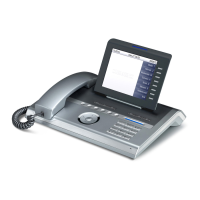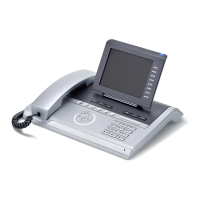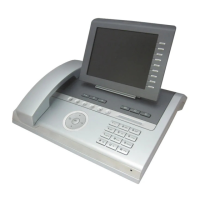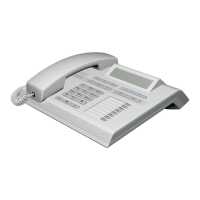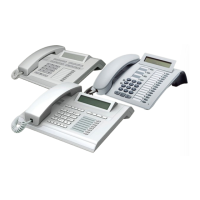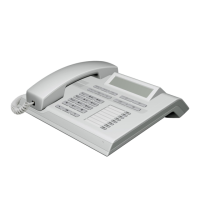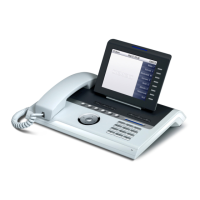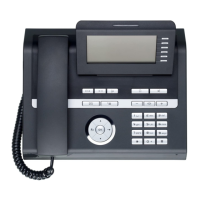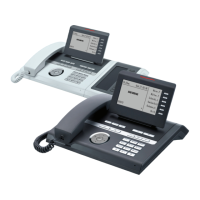Do you have a question about the Siemens OpenStage15 and is the answer not in the manual?
Provides general descriptions of technical options and features, intended for all users.
Explains icons used in the manual to indicate phone or web interface operations.
Identifies and explains the main operating elements and displays on the OpenStage 15 phone.
Details the physical connection ports available on the underside of the OpenStage 15 phone.
Explains the function of various keys: Audio, Mailbox, Menu, and Navigation keys.
Information on the eight illuminated keys that can be assigned functions or numbers.
Describes the phone's keypad layout and character input methods.
Explains the phone's LCD display, including idle mode and icons.
Details how the display content changes based on phone status and events.
Information on accessing call lists, messages, and call logs stored on the phone.
Guide to accessing the menu for local settings and user configuration.
Explains the prerequisite and indication of secure voice communication.
Provides steps for answering incoming calls via handset or speakerphone.
Instructions on how to pick up calls signaled at absent colleagues' phones.
Steps to retrieve a call that has been placed on hold by a colleague.
Guide to changing call audio from handset to speakerphone.
How to mute and unmute the microphone during a call.
Procedures for terminating an active call using handset or speakerphone.
Information on participating in call pickup groups and understanding signaling.
Instructions on initiating calls using off-hook or on-hook dialing methods.
Configuration and use of automatic dialing based on entered characters.
Methods for redialing numbers from call lists or display dialogs.
Steps to add a third participant to an ongoing call for consultation.
Procedures for joining calls to form conferences or transfer them.
Overview of call forwarding conditions and priorities.
Requesting and managing callbacks for busy or unanswered calls.
A list of functions that can be programmed onto the phone's keys.
Instructions for assigning functions to programmable keys via sensor or user menu.
Details on programming advanced functions like Repertory Dial.
Configuring keys to toggle specific phone features like 'make line busy'.
Steps to program keys for specific call forwarding types.
Examples demonstrating the use of programmed keys in different phone states.
Managing incoming calls including deflection, rejection, and forwarding.
Instructions on how to place an active call on hold.
Handling a second incoming call while already engaged in an active call.
Methods for transferring calls, with or without prior consultation.
Configuration for Computer Telephony Integration (CTI) call behavior.
Initiating calls using Direct Station Selection (DSS) keys or call lists.
Setting up and managing local and system-based conferences.
Handling incoming calls on primary and secondary lines.
Procedures for seizing lines and making outgoing calls.
Managing calls on single or multiple lines, including accepting waiting calls.
Steps to place a call on hold using line keys.
Method to join a busy call on a shared secondary line.
Using DSS keys for direct calls, consultations, and call pickup.
Picking up calls for other DSS stations via indirect or direct methods.
Scenarios and procedures for call handling in executive-secretary teams.
Instructions on how to silence the phone's ringer.
Enabling and disabling the Do Not Disturb feature via key or menu.
Information on setting and managing user passwords for phone security.
Steps to activate and deactivate phone lock for unauthorized access prevention.
Overview of possible scenarios for mobility features like logging on/off.
Step-by-step guide for logging into the phone as a mobility user.
Step-by-step guide for logging out of the phone as a mobility user.
Procedures for logging onto phones remotely, including forced logoff.
Using programmable keys to activate/deactivate OpenScape Voice functions.
Controlling caller ID transmission for anonymous or private calls.
Setting up lists to accept or reject calls from specific numbers.
Managing line status within hunt groups for call distribution.
Features for serial and parallel call routing to multiple destinations.
Steps for parking a call and retrieving it later.
Monitoring active calls discreetly or with participant awareness.
Reference table for function codes used in the phone system.
Adjusting display contrast and setting time/date formats.
Manually setting the phone's current time, date, and daylight saving.
Adjusting volume levels for speaker, ringer, handset, and headset.
Configuring room acoustics for speakerphone and selecting ringtones.
Enabling or disabling audible feedback for key presses.
Changing the phone's interface language and country-specific settings.
Displaying IP address, web interface URL, and network status.
Restoring user-specific settings to factory defaults.
Overview of manual, autostart, and all calls recording modes.
Defines recordable and non-recordable call types.
Provides advisories and symbols related to call recording status.
Enabling automatic call recording for all accepted calls.
Steps for activating/deactivating recording and using AutoStart.
Managing recording status during calls: start, pause, end, and consult.
Handling recording during alternated calls and paused states.
Managing conferences and adding participants while recording.
Instructions on how to access the phone's web interface via browser.
Accessing administrative settings protected by an admin password.
Navigating and managing user settings through the web interface.
Accessing phone settings via the on-device user menu.
Displaying IP address, web interface URL, and network status.
Guidelines for cleaning and maintaining the telephone.
Common issues like unresponsive keys, no ringtone, and dialing problems.
Options for labeling phone keys using strips or an online tool.
Provides general descriptions of technical options and features, intended for all users.
Explains icons used in the manual to indicate phone or web interface operations.
Identifies and explains the main operating elements and displays on the OpenStage 15 phone.
Details the physical connection ports available on the underside of the OpenStage 15 phone.
Explains the function of various keys: Audio, Mailbox, Menu, and Navigation keys.
Information on the eight illuminated keys that can be assigned functions or numbers.
Describes the phone's keypad layout and character input methods.
Explains the phone's LCD display, including idle mode and icons.
Details how the display content changes based on phone status and events.
Information on accessing call lists, messages, and call logs stored on the phone.
Guide to accessing the menu for local settings and user configuration.
Explains the prerequisite and indication of secure voice communication.
Provides steps for answering incoming calls via handset or speakerphone.
Instructions on how to pick up calls signaled at absent colleagues' phones.
Steps to retrieve a call that has been placed on hold by a colleague.
Guide to changing call audio from handset to speakerphone.
How to mute and unmute the microphone during a call.
Procedures for terminating an active call using handset or speakerphone.
Information on participating in call pickup groups and understanding signaling.
Instructions on initiating calls using off-hook or on-hook dialing methods.
Configuration and use of automatic dialing based on entered characters.
Methods for redialing numbers from call lists or display dialogs.
Steps to add a third participant to an ongoing call for consultation.
Procedures for joining calls to form conferences or transfer them.
Overview of call forwarding conditions and priorities.
Requesting and managing callbacks for busy or unanswered calls.
A list of functions that can be programmed onto the phone's keys.
Instructions for assigning functions to programmable keys via sensor or user menu.
Details on programming advanced functions like Repertory Dial.
Configuring keys to toggle specific phone features like 'make line busy'.
Steps to program keys for specific call forwarding types.
Examples demonstrating the use of programmed keys in different phone states.
Managing incoming calls including deflection, rejection, and forwarding.
Instructions on how to place an active call on hold.
Handling a second incoming call while already engaged in an active call.
Methods for transferring calls, with or without prior consultation.
Configuration for Computer Telephony Integration (CTI) call behavior.
Initiating calls using Direct Station Selection (DSS) keys or call lists.
Setting up and managing local and system-based conferences.
Handling incoming calls on primary and secondary lines.
Procedures for seizing lines and making outgoing calls.
Managing calls on single or multiple lines, including accepting waiting calls.
Steps to place a call on hold using line keys.
Method to join a busy call on a shared secondary line.
Using DSS keys for direct calls, consultations, and call pickup.
Picking up calls for other DSS stations via indirect or direct methods.
Scenarios and procedures for call handling in executive-secretary teams.
Instructions on how to silence the phone's ringer.
Enabling and disabling the Do Not Disturb feature via key or menu.
Information on setting and managing user passwords for phone security.
Steps to activate and deactivate phone lock for unauthorized access prevention.
Overview of possible scenarios for mobility features like logging on/off.
Step-by-step guide for logging into the phone as a mobility user.
Step-by-step guide for logging out of the phone as a mobility user.
Procedures for logging onto phones remotely, including forced logoff.
Using programmable keys to activate/deactivate OpenScape Voice functions.
Controlling caller ID transmission for anonymous or private calls.
Setting up lists to accept or reject calls from specific numbers.
Managing line status within hunt groups for call distribution.
Features for serial and parallel call routing to multiple destinations.
Steps for parking a call and retrieving it later.
Monitoring active calls discreetly or with participant awareness.
Reference table for function codes used in the phone system.
Adjusting display contrast and setting time/date formats.
Manually setting the phone's current time, date, and daylight saving.
Adjusting volume levels for speaker, ringer, handset, and headset.
Configuring room acoustics for speakerphone and selecting ringtones.
Enabling or disabling audible feedback for key presses.
Changing the phone's interface language and country-specific settings.
Displaying IP address, web interface URL, and network status.
Restoring user-specific settings to factory defaults.
Overview of manual, autostart, and all calls recording modes.
Defines recordable and non-recordable call types.
Provides advisories and symbols related to call recording status.
Enabling automatic call recording for all accepted calls.
Steps for activating/deactivating recording and using AutoStart.
Managing recording status during calls: start, pause, end, and consult.
Handling recording during alternated calls and paused states.
Managing conferences and adding participants while recording.
Instructions on how to access the phone's web interface via browser.
Accessing administrative settings protected by an admin password.
Navigating and managing user settings through the web interface.
Accessing phone settings via the on-device user menu.
Displaying IP address, web interface URL, and network status.
Guidelines for cleaning and maintaining the telephone.
Common issues like unresponsive keys, no ringtone, and dialing problems.
Options for labeling phone keys using strips or an online tool.
| Type | Digital Telephone |
|---|---|
| Connectivity | Ethernet |
| Speakerphone | Yes |
| Power over Ethernet (PoE) | Yes |
| Handset | Standard handset |
| Programmable Keys | Yes |
| Features | Call log, directory, function keys |
| Headset port | Yes |
| Supported Protocols | SIP |
